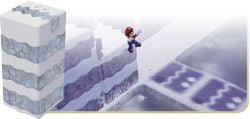Bitefrost
Bitefrosts are invincible enemies encountered in Super Mario Odyssey, appearing in both the Snow Kingdom and the Luncheon Kingdom. Their name is a reversal of the words compounded to form frostbite, the name of a medical condition that causes freezing to the skin or other tissues. They are in the shape of a large pillar, with the top of their bodies being their eyes and two sets of blocky teeth. Bitefrosts hide underground, awaiting for Mario to stand directly above them, and they will rise up above ground, carrying Mario with them. They will wait a few seconds before gnawing their teeth as an attack. Mario can know beforehand when a Bitefrost is below him, as an outline of their faces will be present on the ground (similar to the Sandmaarghs from Super Mario 3D Land). Mario can use Bitefrosts to his advantage to reach higher up places, though he will quickly have to jump elsewhere before the Bitefrosts shut their teeth on him.
The Bitefrosts in Mount Volbono swim in the salt. This gives their bodies a different color[1].
References
- ^ Kazuya Sakai (ed.). The Art of Super Mario Odyssey. First English Edition. Translated by TransPerfect. Milwaukie: Dark Horse, 2019. page 217. ISBN: 978-1-50671-375-5.
Names in other languages
| Language | Name | Meaning | Notes |
|---|---|---|---|
| Japanese | ガブゾー[?] Gabuzō |
From「がぶがぶ」(gabu-gabu, gobbling sound) | |
| Dutch | Bitefrost[?] | - | |
| German | Gefrierbeißer[?] | From gefrieren (freeze) and Beißer (biter). | |
| Italian | Mordighiaccio[?] | From mordicchiare (bite) and ghiaccio (ice). | |
| Korean | 깨물지[?] Kkaemulji |
From "깨물다" (Kkaemulda), which means "to bite". | |
| Russian | Грызолёд[?] Gryzolyod |
From грызть (to gnaw) and лёд (ice). | |
| Spanish | Mordihielo[?] | From morder (bite) and hielo (frost). The name is written in lowercase for the Latin American version ("mordihielo") while it is capitalized in the European version ("Mordihielo"). |


